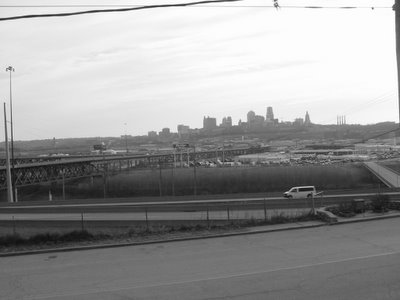What we'll do, in addition to visiting St. Mary's and St. Thomas's, is take a peek at some of the other still-open parishes around town. This should be fun, and won't require a lot of miles in the Curmudgeon car, because Kansas City, Kansas was at one time very compact and predominantly Catholic, so there's an old, interesting neighborhood Church every few blocks. As immigrants came from central and eastern Europe to work in the stockyards, trainyards, packing plants, distilleries and factories that filled the "West Bottoms"
 area at the confluence of the Kaw (Kansas) and the Missouri Rivers (the bottoms being pictured here from the steps of St. John the Baptist, looking east into Missouri), they all established their own neighborhoods in Kansas (the well-to-do, mostly Prot bosses lived on the bluffs overlooking the bottoms from the east, in Kansas City Missouri (many near where the shamefully wrecknovated Cathedral of the Immaculate Conception is located), while the immigrants lived cheap on the Kansas side in tiny houses, on tiny lots, in very linguistically- and culturally- segregated neighborhoods.
area at the confluence of the Kaw (Kansas) and the Missouri Rivers (the bottoms being pictured here from the steps of St. John the Baptist, looking east into Missouri), they all established their own neighborhoods in Kansas (the well-to-do, mostly Prot bosses lived on the bluffs overlooking the bottoms from the east, in Kansas City Missouri (many near where the shamefully wrecknovated Cathedral of the Immaculate Conception is located), while the immigrants lived cheap on the Kansas side in tiny houses, on tiny lots, in very linguistically- and culturally- segregated neighborhoods.
The Croats had their own parish, St. John the Baptist, the Slovenians had theirs, and so did the Czechs and the Poles and the Lithuanians and the Germans and the Russians  (the Russians, of course, having their own schismatic church, complete with an onion dome, as pictured in the distance here, from the steps of Holy Family).
(the Russians, of course, having their own schismatic church, complete with an onion dome, as pictured in the distance here, from the steps of Holy Family).
It will be fun (or so I hope--it would be more fun if we had someone along who could provide insightful commentary instead of just "Oooh, look at this!").
So here we go...
There is a published history of the KCKS side parishes. I've seen it before, but I don't remember the title or anything like that. I am pretty sure it was done for an anniversary of some kind, probably the anniversary of the arch/diocese.
ReplyDeleteMake that all of the Archdiocese in Kansas City of Kansas, not just the KCKS parishes.
ReplyDeleteI have a thin volume (128 pages) my wife picked up at a thrift store or something. Not nearly as involved as This Far By Faith, but it does have about a dozen titles in the bibliography. Drop a line if other searches are unsuccessful. I can arrange to drop it off at a secure but anonymous location, if you prefer.
ReplyDeleteHello, do you happen to know the name of the Russian Orthodox church you have pictured there? I believe it's on 6th and Lowell and I'm just curious about it's history. It makes sense that the Russians would have lived near the Czechs, Poles, Lithuanians and Germans.
ReplyDelete